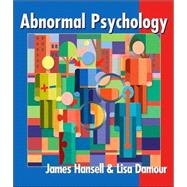
| Abnormal Psychology: The Core Concepts. Case Vignette | |
| The Core Concepts | |
| The Importance of Context in Defining and Understanding Abnormality | |
| The Continuum Between Normal and Abnormal Behavior | |
| Cultural and Historical Relativism in Defining and Classifying Abnormality | |
| The Advantages and Limitations of Diagnosis | |
| The Principle of Multiple Causality | |
| The Connection Between Mind and Body | |
| The Core Concepts: A View From the Past | |
| Chapter Summary | |
| Defining Abnormality: What Is Psychopathology? Case Vignette | |
| Commonly Used Criteria for Defining Abnormality | |
| Help Seeking | |
| Irrationality/Dangerousness | |
| Deviance | |
| Emotional Distress | |
| Significant Impairment | |
| Core Concepts in Defining Abnormality | |
| Cultural and Historical Relativism | |
| The Continuum Between Normal and Abnormal Behavior | |
| Defining Abnormality: Practical Solutions | |
| Working Definitions of Psychopathology | |
| Chapter Summary | |
| Explaining Abnormality:What Causes Psychopathology? Case Vignette | |
| Explaining Abnormality: The Core Concepts | |
| Cultural and Historical Relativism | |
| The Principle of Multiple Causality | |
| The Connection Between Mind and Body | |
| The Theoretical Perspectives | |
| Psychodynamic Perspectives | |
| Humanistic and Existential Perspectives | |
| Behavioral Perspectives | |
| Cognitive Perspectives | |
| Sociocultural and Family Systems Perspectives | |
| Biological Perspectives | |
| Case Vignette Explanation and Treatment | |
| Classifying Abnormality: Diagnosis and Assessment | |
| The Advantages and Limitations of Diagnosis | |
| Reliability | |
| Validity | |
| The History of Diagnostic Systems for Psychopathology | |
| The DSM-III Revolution and Controversy | |
| Advantages of the Modern DSM Approach | |
| Limitations of the Modern DSM Approach | |
| Using the DSM-IV-TR: Making a Multiaxial Diagnosis | |
| Axis I and Axis II | |
| Axes III, IV, and V | |
| A Complete DSM-IV-TR Diagnosis | |
| Assessment | |
| Interviews | |
| Tests | |
| Behavioral Observation | |
| Diagnosis and Assessment in Perspective: Classifying and Understanding Dave | |
| Interview with Dave | |
| Dave's Test Results | |
| Behavioral Observations of Dave | |
| The Advantages and Limitations of the Diagnosis of Dave | |
| Anxiety and the Anxiety Disorders | |
| Case Vignettes | |
| Defining Anxiety and Anxiety Disorders | |
| The Importance of Context in Defining Anxiety Disorders | |
| The Continuum Between Normal and Abnormal Anxiety | |
| Classifying Anxiety Disorders | |
| The DSM-IV-TR Categories | |
| The Advantages and Limitations of the DSM-IV-TR Anxiety Disorder Diagnoses | |
| Classification in Demographic Context | |
| Cultural and Historical Relativism in Defining and Classifying Anxiety Disorders | |
| Explaining and Treating Anxiety and Anxiety Disorders | |
| Behavioral Components | |
| Cognitive Components | |
| Biological Components | |
| Psychodynamic Components | |
| The Multiple Causality of Anxiety Disorders | |
| The Connection Between Mind and Body in Anxiety Disorders | |
| Case Vignettes- Treatment | |
| Mood and the Mood Disorders | |
| Table of Contents provided by Publisher. All Rights Reserved. |
The New copy of this book will include any supplemental materials advertised. Please check the title of the book to determine if it should include any access cards, study guides, lab manuals, CDs, etc.
The Used, Rental and eBook copies of this book are not guaranteed to include any supplemental materials. Typically, only the book itself is included. This is true even if the title states it includes any access cards, study guides, lab manuals, CDs, etc.